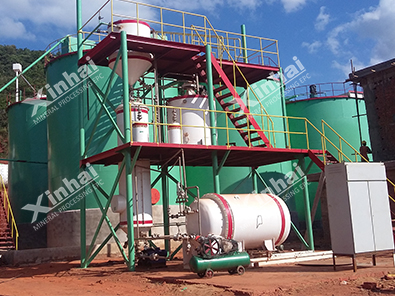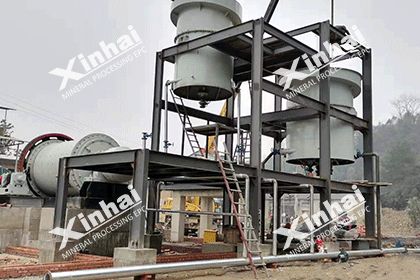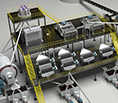4 Factors Affecting the Gold Adsorption of Activated Carbon
 Shirley
Shirley
 Apr 30, 2021
Apr 30, 2021
 2785
2785
If you want to know more details about equipment, solutions, etc, please click the button below for free consultation, or leave your requirements!

There are three types of methods for extracting gold from cyanide pulp by activated carbon adsorption: carbon in pulp (CIP method), carbon in leach (CIL method) and carbon in column (CIC method). The adsorption process and principle of activated carbon are complex, so there are many influencing factors. This article will explain its influence on the gold adsorption effect of activated carbon from four aspects: raw material, activation treatment, impurity ions and pH value.
01 Effect of Activated Carbon Raw Materials on Gold Adsorption
BackAt present, it is generally believed that the best raw material for making activated carbon is coconut shell, which mainly has the advantages of large surface area, large micropore volume, fast adsorption speed, large adsorption capacity for gold, good wear resistance and easy reactivation and utilization. Next are by sawdust, charcoal, followed by coal, petroleum pitch and slime. However, due to the limited resources of wood materials and the high cost, people do not advocate using wood as raw materials in the context of increasing awareness of environmental protection.
02 Effect of Activated Carbon Activation Treatment on Gold Adsorption
BackThe effect of activation treatment on the adsorption of gold is realized by changing the pore structure and distribution of carbon. As the activation temperature increases, the skeleton density, micropore volume and surface area of activated carbon increase significantly. The increase in skeleton density is consistent with the graphitization process in a certain temperature range, and the density of pure graphite is 2.23g/cm3 in a higher temperature range. The skeleton density of charcoal produced in different activation atmospheres and from different raw materials is very similar, only the skeleton density of wood charcoal is much lower. The micropore volume increases significantly in the processing temperature range of 650-850°C. Studies have shown that when the activation temperature is increased from 650℃ to 850℃, the gold loaded carbon can increase by 10 times.
03 Effect of Impurity Ions in the Leaching Solution on Gold Adsorption
BackIn gold cyanidation process, in addition to gold and silver will be dissolved into the leaching solution by cyanide, copper, cobalt, nickel, mercury and arsenic will also be dissolved by cyanide to varying degrees. The concentration of free cyanide in the leaching solution plays an important role in the adsorption of copper by activated carbon. When the ratio of free cyanide to copper is small, copper in the leaching solution exists as [Cu (CN) 2] - complex anion, which can be well adsorbed by activated carbon, resulting in the reduction of the capacity of activated carbon to adsorb gold. When the ratio of free cyanide to copper in the leaching solution is high, copper exists in the leaching solution in the form of [Cu (CN) 3] 2- and [Cu (CN) 4] 3-, while activated carbon has a weak adsorption capacity for such high-price anions, so it has little influence on the adsorption amount of gold.
The effect of silver in leaching solution on gold adsorption by activated carbon is related to the ratio of silver to gold. When the ratio of silver to gold is equal to 1, the adsorption capacity of activated carbon to gold decreases slightly. When the ratio of silver to gold is greater than 2, the adsorption capacity of activated carbon to gold decreases obviously. In short, a small amount of copper, cobalt, nickel and zinc in the leaching solution has little effect on the adsorption of gold by activated carbon. However, due to the adsorption of these impurity ions occupied the position of the active group, the amount of activated carbon adsorption of gold and silver is reduced.
04 Effect of Leaching Solution pH on Gold Adsorption
BackThe gold-carrying capacity of activated carbon is the largest when the leaching solution pH is 2.5~5.0. When the pH is greater than 6, the gold loading of activated carbon decreases with the increase of the leaching solution pH, but it is not obvious. When the pH is less than 9.0, cyanide (CN-) is easily hydrolyzed into highly toxic hydrocyanic acid (HCN) gas and escapes, endangering the health of operators and increasing the consumption of cyanide. Therefore, during gold heap leaching process, the pH is generally controlled in the range of 9.5 to 10.5. In this pH range, the effect of pH on the gold loading of activated carbon is not obvious.
05To Wrap Up
BackIn addition to the above four influencing factors, adsorption equipment, aeration volume, and slurry concentration will also affect the effect of activated carbon adsorption. In actual production, it is necessary to select the appropriate type of activated carbon according to the needs of the project, control the various influencing parameters in the adsorption process, and ensure the normal operation of the gold adsorption process.
 +86 182 3440 3483
+86 182 3440 3483 yanzhang19990421@gmail.com
yanzhang19990421@gmail.com




 Message
Message Chat Now
Chat Now



















